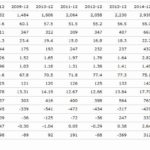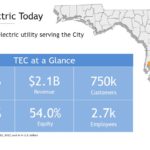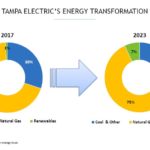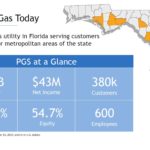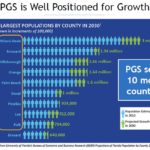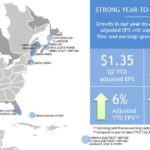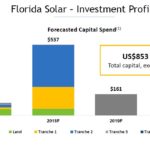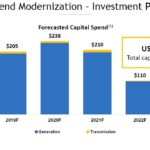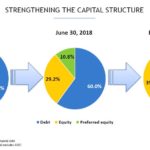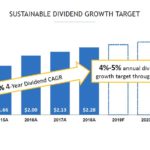Contents
 Summary
Summary
- This company has more than doubled its annual revenue since FY2015.
- Growth is being generated primarily from the US, as opposed to Canada, subsequent to the completion of a very significant acquisition in 2016.
- The company will be incurring significant CAPEX over the next few years. As a prudent measure, the historical dividend growth has been scaled back so as to incorporate a higher component of internally generated funds in the capital plans to fund these accretive investments.
- The company’s dividend is attractive and deemed safe which will make this stock appealing to investors seeking dividend income.
All figures are reported in CDN $ unless otherwise noted.
Introduction
My most recent article covered a company that would appeal to investors seeking long-term capital growth as opposed to a steadily increasing source of dividend income. The company covered in today’s article will most likely appeal to investors seeking a safe stream of quarterly dividend income.
This company recently announced a ~4% dividend increase. Based on the stock price as at the time this article is being written, the dividend yield is ~5.85%. This yield is further enhanced if you elect to enrol in the company’s DRIP (dividend reinvestment program); the company’s DRIP stipulates that ‘there may be a discount of up to 5% from the average market price for shares purchased in connection with the reinvestment of cash dividends’.
Business was predominantly generated from within Canada but over the past couple of years the company has transitioned to one where a majority of its earnings comes from its US subsidiaries. The rationale for this company’s expansion into the US market is because that market:
- offers the ability to generate higher returns;
- there are superior growth opportunities.
Due to this company’s recent radical transformation, comparing the company of today and that of the past is ill-advised; the company’s revenue has more than doubled to over $6.2B (FYE2017) versus ~$2.8B as at FYE2015 (it generated ~$1.3B in annual revenue in FY2008).
This growth has come primarily by way of acquisition. Growth has been financed through the raising of additional equity and considerable additional debt. Moody’s and S&P Global, however, have not amended this company’s long-term unsecured debt ratings in several years.
Furthermore, Goodwill, that intangible asset that arises when a buyer acquires an existing business, has ballooned as a result of these acquisitions.
Nova Scotia Power generates allowed returns that are generally lower than in the US. It typically enjoys a lower cost of capital than U.S. counterparts and it is not subject to an annual general rate base review, which can increase regulatory uncertainty.
The Newfoundland and Labrador transmission projects and Brunswick pipeline offer strong efficient scale advantages. Capital costs for competing transmission systems would be too high to offer a sufficient return on capital for new entrants.
The Caribbean utility portfolio faces higher political risk when compared with Canadian and US utility portfolios. It is, however, granted meaningfully higher allowed returns to compensate for this additional risk.
Business Overview
Emera Inc. (TSX: EMA.TO) is an energy and services company headquartered in Halifax, Nova Scotia. It invests in electricity generation, transmission and distribution, gas transmission and distribution, and utility energy services with a strategic focus on transformation from high carbon to low carbon energy sources.
As noted in the Introduction of this article, EMA has transitioned from a predominantly Canadian utility to one where a majority of earnings come from U.S. subsidiaries. The magnitude of this company’s transformation over the years is such that there have been huge swings in its year-end financial results as evidenced from the following table.
Source: Morningstar
EMA’s Nova Scotia Power generates allowed returns that are generally lower than in the US. It typically enjoys a lower cost of capital than U.S. counterparts and it is not subject to an annual general rate base review, which can increase regulatory uncertainty.
The Newfoundland and Labrador transmission projects and Brunswick pipeline offer strong efficient scale advantages. Capital costs for competing transmission systems would be too high to offer a sufficient return on capital for new entrants.
The Caribbean utility portfolio faces higher political risk when compared with Canadian and US utility portfolios. It is, however, granted meaningfully higher allowed returns to compensate for this additional risk.
In mid-2016, EMA completed its USD $10.4B acquisition (includes debt) of TECO Energy. Through this acquisition, EMA expected to increase the portion of its earnings from rate-regulated businesses to almost 85% of adjusted net income. Upon completion of this acquisition, EMA became a top 20 North American regulated utility with added geographic, regulatory and business diversification.
Fiscal 2017 marked the first full year of operations with Tampa Electric, Peoples Gas and New Mexico Gas; TECO acquired New Mexico Gas for USD $1B in 2014. Through the acquisition of TECO, EMA significantly expanded its customer base.
Tampa Electric serves nearly 750,000 customers in West Central Florida;
Source: EMA Investor Day – June 21, 2018 Investor Presentation
Source: EMA - Q2 2018 Investor Presentation August 10 2018
Peoples Gas serves nearly 375,000 customers across Florida;
Source: EMA Investor Day – June 21, 2018 Investor Presentation
New Mexico Gas Co. serves more than 525,000 customers across New Mexico.
Additional details on EMA’s affiliates in North America and in four Caribbean countries can be accessed here.
A comprehensive business overview and outlook for each entity within the EMA fold can be found starting on page 23 of 172 in the 2017 Annual Report.
Q2 2018 Financial Results
On August 10, 2018, EMA released its Q2 and YTD results.
Source: EMA - Q2 2018 Investor Presentation August 10 2018
Unfavorable weather at the Florida and New Mexico utilities along with a stronger Canadian dollar lowered U.S. earnings which negatively impacted Q2 consolidated earnings.
Earnings at Emera Energy, the company's unregulated merchant unit, increased due to higher New England capacity market revenue and the absence of an unplanned outage in 2017.
Key growth investments remain on track. In particular, TECO is installing 600 MW of solar in Florida. As at the end of Q2, EMA has spent USD $0.4B of the total USD $0.85B forecast; the first 145 MW will come online late 2018 with the remaining 250 MW scheduled for early 2019. Favorable regulatory treatment allows for immediate recovery of investments upon start of operation.
Source: EMA Investor Day – June 21, 2018 Investor Presentation
TECO also recently announced a USD ~$0.85B investment plan to modernize the Big Bend Power Station.
Source: EMA Investor Day – June 21, 2018 Investor Presentation
Credit Ratings
Moody’s initiated coverage in June 2016 and assigned an unsecured long-term debt credit rating of Baa3. This rating has remained unchanged since such time. This rating is the lowest tier of the Lower Medium grade category.
S&P Global has assigned a BBB+ unsecured long-term debt credit rating since September 2009 but this rating was placed on ‘Credit Watch’ in December 2017. This rating is the top tier of the Lower Medium grade category.
Both ratings are Investment-grade ratings but measures have been implemented to ensure EMA’s ratings remain at an investment-grade level throughout EMA’s expansion.
Source: EMA - Q2 2018 Investor Presentation August 10 2018
Valuation
EMA is currently trading at ~$40.25 after having pulled back from an early October 2017 high of ~$49.50.
In the first half of FY2018, EMA generated $1.35 in adjusted EPS. The current mean adjusted EPS estimate for FY2018 based on estimates from 13 analysts is $2.75 with a range of $2.67 - $2.88; EMA reported adjusted EPS in FY2014 - FY2017 of $2.17, $2.26, $2.77, and $2.46. Using the current stock price and the mean adjusted earnings estimate of $2.75 I arrive at a forward adjusted PE of ~14.64.
This forward PE is slightly below that of its much larger peer Fortis Inc. (TSX: FTS) at ~21 and slightly larger peer Hydro One (TSX: H) at ~18.6.
I view EMA as fairly priced at its current level.
Dividend, Dividend Yield and Dividend Sustainability
EMA’s dividend history can be found here.
While shareholders have been rewarded with an 11% 4-year dividend compound annual growth rate, the Board has revised its annual dividend growth rate target to a range of 4% - 5% until 2021. This is more in line with the industry average and will enable EMA to free up capital for growth projects.
In the Q2 2018 earnings release, EMA’s President & Chief Executive Officer indicated that EMA
“has significant regulated rate base investment opportunities, including USD $1.7B of investment at Tampa Electric in 600 MW of new solar generation and a modernization of the Big Bend station. These projects will drive both significant value for customers and strong investment returns for shareholders. We believe that it is prudent to incorporate a higher component of internally generated funds in the capital plans to fund these accretive investments and as a result have modified our annual dividend growth target. EMA’s average EPS growth is expected to exceed dividend growth over the guidance period.”
Source: EMA – Q2 2018 Investor Presentation – August 10, 2018)
In keeping with this more moderate dividend growth rate, EMA announced an increase in its $0.565 quarterly dividend to $0.5875 (~4% dividend increase) on August 10, 2018.
On the basis of the August 14th $40.25 closing stock price, the $2.35 annual dividend yields ~5.8%. Add in the 5% discount if you enrol in EMA’s DRIP (dividend reinvestment program) and your dividend yield allows you to be a patient investor.
Final Thoughts
EMA is no longer the same business as it was just a few years ago, and therefore, comparing the EMA of today with the EMA of as recently as 2015 is not recommended.
EMA has undergone, and is undergoing, a radical transformation. I am of the opinion the strategic decision to expand in the US is the right decision even though EMA paid up for the companies it acquired.
I recognize the reduction in the dividend growth may not sit well with some EMA shareholders. I, however, view management’s decision on its dividend policy as in the best interests of the company. I am a firm believer that investing properly for the future should take precedence over an attractive dividend/dividend growth.
I am prepared to put up with slow dividend growth given that the dividend yield is already attractive. I will not, however, be acquiring additional shares other than through the automatic reinvestment of dividends (an additional 7 – 8 shares quarterly based on current metrics).
I wish you much success on your journey to financial freedom.
Thanks for reading!
Note: I sincerely appreciate the time you took to read this article. Please send any feedback, corrections, or questions to [email protected]
Disclaimer: I have no knowledge of your individual circumstances and am not providing individualized advice or recommendations. I encourage you not to make any investment decision without conducting your own research and due diligence. You should also consult your financial advisor about your specific situation.
Disclosure: I am long EMA.
I wrote this article myself and it expresses my own opinions. I am not receiving compensation for it and have no business relationship with any company whose stock is mentioned in this article.


